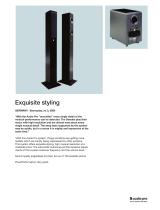1
4
The Quad II-forty power amplifiers are much more than
a tribute to one of the most famous designs in audio -
they are both refined and powerful in the modern sense
of the terms.
Although the circuit topology has changed little from
the original, significantly better components and a
brand new transformer design - still delicately balanced -
means that they are fast, crisp and detailed, whilst
producing an output current, more than capable of
driving modern loudspeaker loads, even our own ESL
loudspeakers are well within their capabilities.
The champagne finished chassis is strong and heavy,
internally wired with solder tags - not PCBs. The KT-88
output valves in push-pull configuration are visually
“Factor out nostalgia. Forget the miracle of Quad making
valve amps in the 21st century. Look at the Quads in terms
of a current pre/power tube combination. Then look at the
opposition. Now factor in gorgeous styling, superb build
quality, perfect ergonomics, ample grunt, genuine heritage
and the kind of sound which allows valve enthusiasts to
show two fingers to transistor users.”
– Ken Kessler, Hi-Fi News
stunning, sitting safely within a cage to protect them.
Gold-plated phono connectors replace the ‘Jones’ plugs
of the original - with a choice of 4ohm or 8ohm taps,
allowing for the widest possible choice of loudspeakers.
Every product we make is hand-built by craftsmen for a
lifetime of duty. Quad products rarely, if ever, need
replacing and we regularly service and maintain
products over fifty years old.
This means many of the original Quad II amplifiers have
been passed down, into the hands of the children - and
even grandchildren - of the original owners, something
that is uniquely Quad in essence. A product that is
relevant today and will remain so for generations to
come.


















